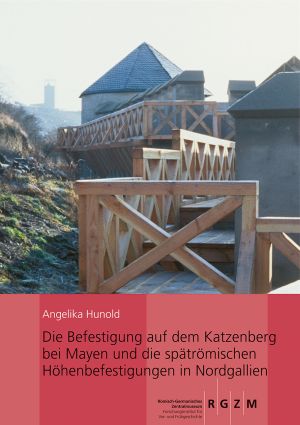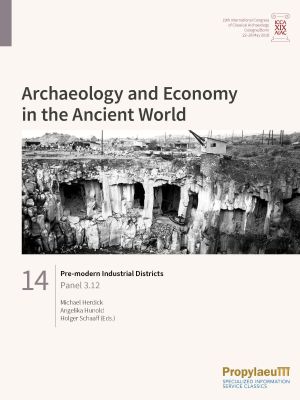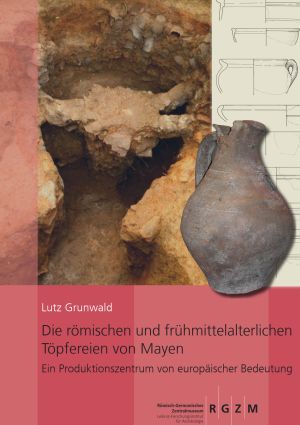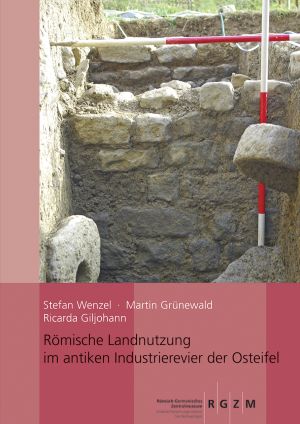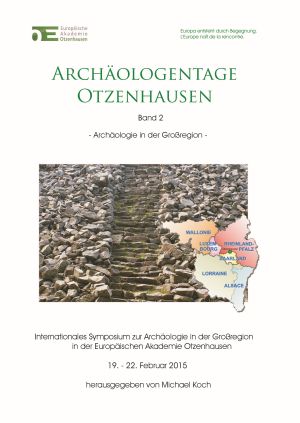Hunold, Angelika
Die Befestigung auf dem Katzenberg bei Mayen und die spätrömischen Höhenbefestigungen in Nordgallien
On the Katzenberg near Mayen, a military fortification, one of the largest of its kind, existed from about 300 AD until the middle of the 5th century to protect the economic centre of Mayen.
Based on the results obtained there, 143 other hill fortifications in northern Gaul are examined. Oriented along traffic routes, especially waterways, these fortifications by no means have the character of hidden refuges. Rather, they can also be classified as military installations that were integrated into an overarching defence concept. They ensured the continuity of civil and economic life in rural areas. Thus, hilltop fortifications are one of the elements of a deep military defence in Late Antiquity.
Pre-modern Industrial Districts: Panel 3.12
The ancient quarrying and mining district of the Eastern Eifel has been the subject of research by the Römisch-Germanisches Zentralmuseum (RGZM) in Mainz and Mayen since 1997. The products – primarily basalt lava millstones, tuffstone building material, and pottery – were extensively traded throughout much of Europe for many centuries.
An extensive research programme was launched to examine the wealth of evidence about the ancient stone industry in the region and its significance for the political establishment of Rome north of the Alps. The main subjects were the basalt and tuff stone industries as well as the Mayen vicus, the most important economic centre. Another subject is the pottery production, which is researched by material studies as well as by experimental archaeology. Other studies deal with the preconditions for the economic success, focussing on the infrastructure and the rural settlement conditions.
Being an industrial district of supraregional importance, the quarrying and mining district of the Eastern Eifel turned out an excellent case study for the investigation of pre-modern industrial districts in general, providing a model for the study of ancient industries: these need to be investigated with a long-term view and with a holistic approach, taking into account economic, social and settlement aspects.
Die römischen und frühmittelalterlichen Töpfereien von Mayen: Ein Produktionszentrum von europäischer Bedeutung
The Mayen ware produced in Mayen is considered characteristic and relevant to dating. These ceramic products were formative for parts of the ancient European economic structure. The Mayen potteries were part of the pre-modern industrial area between the Eastern Eifel and the Rhine. Here, a seamless transfer of knowledge and technology from the Roman era to the early Middle Ages took place throughout the 5th century. The study goes beyond the typochronological assessment of the vessel pottery. It also addresses aspects of the individual lives of the potters in their multi-layered lifeworlds, such as their beliefs, their dependencies on property or the monetary economy.
Römische Landnutzung im antiken Industrierevier der Osteifel
From the beginning of the Roman Imperial period, the area between Mayen on the edge of the Eifel and Andernach on the Rhine experienced an enormous increase in its economic activity. In a short time, an industrial area developed there, from which wide areas in the Roman north-western provinces were supplied with high-quality basalt lava millstones, light tuff and later also heat-resistant ceramics. Quarries were newly established, land and water routes were expanded, existing outlets were extended and others were still to be developed. Setbacks in the 3rd and 4th centuries were followed by further booms.
How could the numerous workers and their families be fed, and what consequences did the success of the stone and energy-intensive pottery industries have for the environment? In order to clarify this, two Roman villas on the northern edge of the Mayen millstone quarries were investigated with geophysical measurements, excavations, geoarchaeological and botanical studies, and their entire surroundings were explored. The results are presented in this book. The inhabitants of the villa Mendig, »Im Winkel« were themselves involved in the production of millstones. In late antiquity, a surface drainage system there probably kept a transhipment point for millstones on the Segbach dry, while a fortified storage building ensured the supply of the quarrymen. Quarry owners resided in the villa Mendig, »Lungenkärchen«. It turned out to be an axial courtyard with an impressive water basin. Inspections led to the discovery of the burial ground belonging to »Lungenkärchen« with monuments made of Lorraine limestone as well as the discovery of a previously unknown vicus »Im Terl«.
Archäologie in der Großregion: Beiträge des internationalen Symposiums zur Archäologie in der Großregion in der Europäischen Akademie Otzenhausen vom 19. - 22. Februar 2015
The present conference proceedings document the lectures and presentations of the 2nd Otzenhausen Archaeology Days and thus make them accessible to those who were not able to attend the Archaeology Days. It is not possible to document the countless conversations and "border crossings" that took place on the sidelines and during the breaks, in the evenings and during the excursions. And yet it is precisely these that make the Otzenhausen Archaeology Days so appealing.



